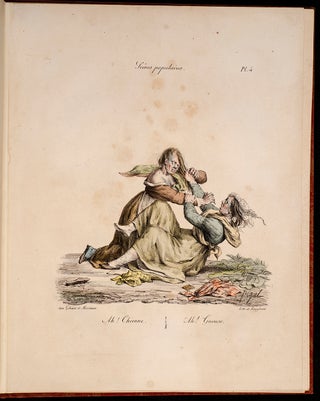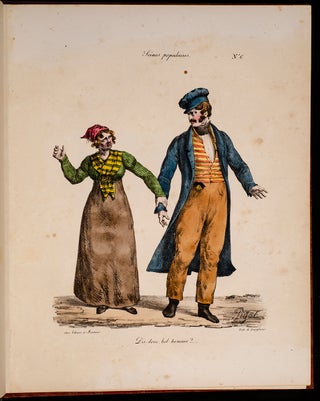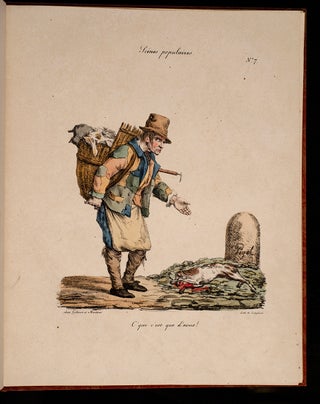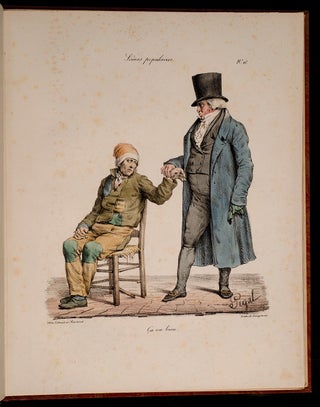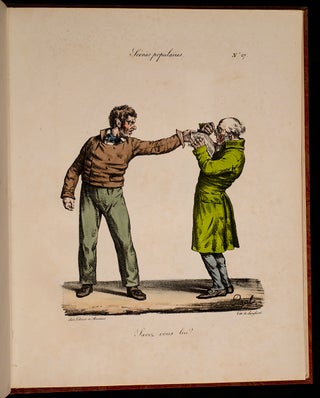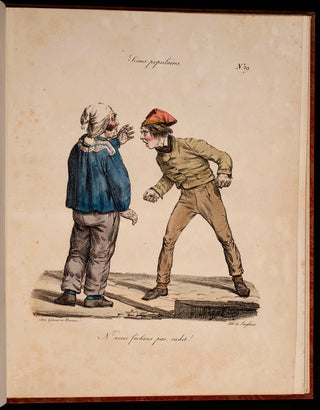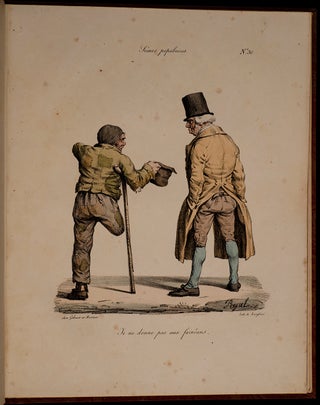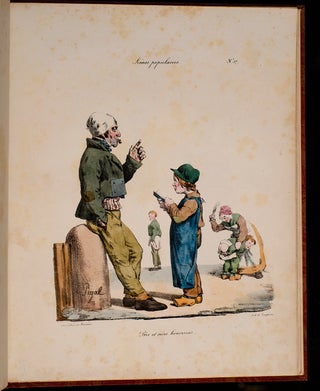Recueil de Scenes Populaires
Paris: Chez Martinet et Gihaut, 1822. Item #05255
Fifty-Two Highly Amusing Hand Colored Lithograph Plates Showing the People of Paris
PIGAL, Edmé-Jean. Recueil de Scenes Populaires. [Collection of Popular Scenes]. Paris: Chez Martinet et Gihaut, [1822].
First edition. Folio (12 1/2 x 10 1/8 inches; 318 x 258 mm.). Lithograph title-page and fifty-two superb hand colored lithograph plates all mounted on stubs. All of the plates are lithographed by Langlumé.
Late nineteenth century maroon pattered boards, smooth spine with brown morocco label ruled and lettered in gilt.
A few plates with light mainly marginal foxing, plate no. 37 with small 3/4 inch lower marginal repair; plate no. 39 with lower blank corner restored (1 1/8 x 7/8 inch); plate no 48 slightly shorter on top and lower margins and plate 49 with light marginal stain fro stub of previous plate. Still a near fine example of this very scarce and highly amusing book.
The two additional plates are numbers 6 [bis] and 37 [bis].
We can locate just three copies in Libraries and Institutions worldwide (all with fifty plates only):
1. The Morgan Library & Museum (NY, US)
2. The Art Institute of Chicago (IL, US)
3. Brown University RI, US)
These plates exist colored or plain, they all bear the title Popular Scenes at the top, followed by the plate number and below the title, the Publisher and the Lithographer. These humorous scenes each show two or three characters and are highly interesting for depicting the costumes of the people of Paris. (Translated from Colas).
"Even Beraldi admits that Pigal is an "expert lithographer in execution." The drawing for "Rely on me, my dear fellow" shows how little has been lost between it and the print." (Gordon Ray, The Art of the French Illustrated Book, p. 196).
"A major French nineteenth century artist and caricaturist, Edmé-Jean Pigal [1798-1873] studied art in Paris in the studio of Baron Gros. He first exhibited his paintings at the Paris Salon in 1827 and continued to annually exhibit his art there for more than thirty years. Pigal's early art was mainly in the medium of lithography. After 1838 he turned more towards painting, particularly religious and historical scenes commissioned by the French government. His last years were spent as a professor of art at the Lycee in Sens.
"Although he was a fine painter it is the lithographic art of Pigal which remains his finest legacy. Beatrice Farwell writes:
'From the late 1820's to the late 1830's, he (Pigal) produced numerous lithographs caricaturing contemporary customs and social types, in which he ridiculed the hypocrisy of the bourgeoisie and the vulgarity of the lower classes. His favorite characters were the street urchins of Paris, servants, coachmen and doormen, and lecherous old men' (Beatrice Farwell, The Charged Image: French Lithographic Caricature, 1816-1848, Santa Barbara Museum of Art, Santa Barbara, 1989, p. 127).
"Pigal's early lithographic work (c. 1820-1830) concentrates upon the actions of one or two main figures and provides little or no background setting… His lithographs created for individual sale (as opposed to those appearing in the journals) were most often hand-colored before publication.
"In some respects Pigal's earthy brand of caricature was closer to the English satirical art of Gillray, Cruikshank and Rowlandson than to the political and social satires of his French contemporaries, such as Daumier and Gavarni. Perhaps for this reason Pigal's lithographs were very popular in Britain…" (http://www.artoftheprint.com/artistpages/pigal_edme_jean_).
"Pigal's scenes of the people are good. It is not that the originality is very lively, nor even that the design is very comic. Pigal is comical in moderation, but the feeling in his compositions is good and just. These are vulgar truths, but still truths" (Baudelaire, Oeuvres complètes, 1964 edition, p. 995).
"Pigal does play to the groundlings, and no one would accuse him of excessive delicacy, but he knew his world and could depict it incisively in his lithographs" (Ray, The Art of the French Illustrated Book, p.196). Pigal's albums "have documentary value, and their fresh and unaffected representation of the people, dress, and scenes of the time gives them a degree of charm' (Ray, p. 189).
Colas and Hiler highly commend these plates for their humor and depiction of contemporary fashion and costume.
Colas 2365; Hiler, p. 710; Ray, The Art of the French Illustrated Book 1700-1914, No. 130. Not in Bobins or Lipperheide
The Plates:
1. Grand Savoyard!.. Méchant Gamin…
Great Savoyard!.. Bad Kid…
2. Tais-toi, rosse! Tu m’em…bétes.
Shut up, bastard! You annoy me.
3. On vient.
We come.
4. Ah! Chienne. Ah! Gueuse.
Ah! Female dog. Ah! Pigeon.
5. à bas les pattes!...
hands off!...
6. Femme, sachez vous taire?
Woman, can you be silent?
6 bis. Dis-donc, bel homme?...
Say, handsome man?...
7. C’que c’est que d’nous!
What it is that of us!
8. Queq’tu veux, Gringalet?
What do you want, Gringalet?
9. C’est ma fille, Monsieur.
She's my daughter, sir.
10. Y es tu? Là.
Are you there? The.
11. Respect au sesque et à la vieillesse, canailles!
Respect to the sense that and to old age, scoundrels!
12. Reviens-y, polisson!
Come back, prank!
13. Mords-le, faro!...
Bite it, faro!...
14. Je l’aurai! Tu ne l’auras pas!
I will have it! You won't get it!
15. Allons! Faignant!
Lets go! Lazy!
16. Ça va bien!!
Things are going well!!
17. Qué qui te pale, blanc bec?
What pales you, white beak?
18. Ces dames dansant ells?
These dancing ladies?
19. Ah! j’ris ti!...
Ah! I'm laughing!...
20. Qui s’y frotte s’y pique.
If you go looking for trouble you'll find it.
21. Manman, z’ai fini!
Mom, I'm done!
22. Ohe! C’te farce.
Ah! It's a joke.
23. Ah! Ah! la vilaine bête.
Ah! Ah! the ugly beast.
24. Li après?
Read after?
25. Parlons peu z’et parlons bien.
Let's talk little and let's talk well.
26. Qué dui t’a fait, c’coquin là?
What did you do, that rascal?
27. Savez-vous lire?
Can you read?
28. Pour un iard, Madame?
For a fortune, Madame?
29. N’nos fâchons pas, cadet!
Don't get mad, cadet!
30. Je ne donne pas aux fainéans.
I don't give to lazy people.
31. Haie! Haie! Les bébêtes.
Hedge! Hedge! The cornies.
32. Tout à l’heure, bobonne, tout à l’heure.
Any time, bobonne, any time.
33. Tu sais c’qu’on f’dit?
Do you know what we say?
34. A mon tour!
My turn!
35. Voyez vous ça?
Do you see that?
36. Et moi aussi, je la suis.
And so am I.
37. Père et mère honoreras.
Father and mother will honor.
37 bis. Quelle voix d’Centaure!...
What a Centaur's voice!...
38. Léusses tu cru? Je m’en avais douté.
Did you believe it? I had suspected it.
39. Ce n’est pas pour vous, beau Sire.
This is not for you, fair Sire.
40. Aprés moi, s’il en reste.
After me, if there are any left.
41. De quoi vous mêlez-vous?
What are you getting involved in?
42. C’et mon cousin.
It's my cousin.
43. J’t’aim’ tant!
I love you so much!
44. u…u…un instant, cam’rade.
u…u…wait a minute, mate.
45. Amoroso.
Amorous.
46. J’vous valons ben, p-t-etre?
Am I worth you, maybe?
47. Avalons la douleur.
Let's swallow the pain.
48. Pour qui me prenez-vous?
Who do you take me for?
49. Quel gaillard! Qu’en dis-tu, ma femme? Hé! Hé! Hé!
What a fellow! What do you say, my wife? Hey! Hey! Hey!
50. Comme ça vous va!
As it suits you!
Price: $12,500.00

 I have been in the rare and antiquarian book business for over forty years; my family has been in the rare books business since 1876. Rare books are in my blood.
I have been in the rare and antiquarian book business for over forty years; my family has been in the rare books business since 1876. Rare books are in my blood.





